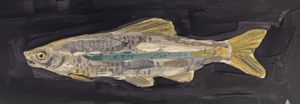Ocmulgee shiner facts for kids
Quick facts for kids Ocmulgee shiner |
|
|---|---|
| Conservation status | |
| Scientific classification | |
| Synonyms | |
|
The Ocmulgee shiner (scientific name: Cyprinella callisema) is a type of fish. It belongs to the Cyprinidae family, which includes many minnows and carps. This fish lives only in the United States. You can find it in the Altamaha and Ogeechee rivers in Georgia.
A scientist named David Starr Jordan first described this fish. He wrote about it in a book in 1877. Jordan was famous for discovering over 2,500 different kinds of fish!
What Does It Look Like?
The Ocmulgee shiner is a slim, silver minnow. It often has a shiny blue color. A clear line, called a lateral line, runs along its side. This line goes from its head all the way to its tail.
These minnows can grow up to 9 centimeters (about 3.5 inches) long. They have six fins to help them swim.
- A forked tail fin helps them swim fast and turn quickly.
- Two pectoral fins help them move up and down in the water.
- One dorsal fin, one anal fin, and two pelvic fins help them stay steady.
The fins are usually a light yellow color. They are also mostly see-through. The Ocmulgee shiner has a mouth at the very front of its head. This is called a terminal mouth.
Where Does It Live?
This fish is native to Georgia in the United States. It is a freshwater fish that likes warm water. It lives mainly in the Ocmulgee and Oconee river basins.
The Ocmulgee shiner prefers rivers with sandy or rocky bottoms. It lives in small to medium-sized rivers. You can find it in areas between 32°N and 34°N latitude.
Life Cycle and Habits
The Ocmulgee shiner is part of the Cyprinidae family. Like other fish in this family, they lay eggs. This is how they reproduce.
Scientists do not know much about what they eat. However, it is thought that they eat small invertebrates and plants. Invertebrates are tiny creatures without backbones, like insects.
Current Status
The IUCN Red List helps us know if a species is in danger. It shows how likely a species is to become extinct. The Ocmulgee shiner is listed as a species of "least concern." This means its population is stable and not at risk right now. The last time its status was checked was in 2011.



